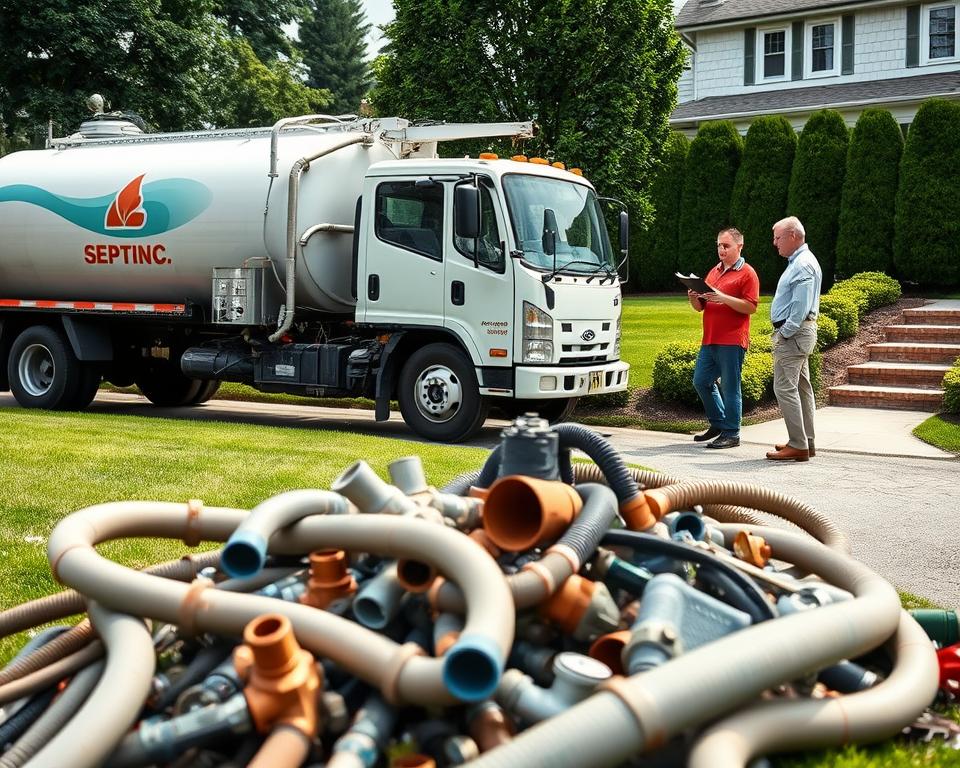Onsite Wastewater System: Your Manual to Selection & Maintenance
Did you know almost one in five U.S. homes uses a septic system for wastewater treatment? This statistic demonstrates how vital it is to know about septic wastewater pumps. If you’re unfamiliar with septic setups or thinking of 24 hour septic pumping near me, understanding septic pumps is crucial. It assists in managing sewage at your residence.
This manual will provide you with an overview on septic setup pumps. It aids in keeping your wastewater pump operates smoothly and prevents expensive fixes. By learning about septic setups and the septic effluent pump’s function, you can make smart choices. These decisions will enhance your sewage treatment’s effectiveness and longevity.
Getting to Know the Essentials of Septic Systems
Septic setups are key for homes not connected to city sewers. They process and dispose of household sewage. Knowing how they work is crucial for keeping them running right.
What Is a Septic Setup?
A septic system is an underground arrangement for wastewater treatment. It’s commonly found in countryside and residential areas. It decomposes waste and fluids, letting waste to decompose naturally with microorganisms. The treated water then goes into the ground, finishing the treatment.
Parts of a Septic System
The main components of a septic setup are:
- Conduits from the home
- Septic tank
- Leach field
- Soil
These components work together to treat wastewater well. The septic reservoir is where the majority of treatment happens. The leach field spreads out the treated water into the earth.
How Wastewater is Processed
Initially, wastewater goes into the septic reservoir. There, it settles. Waste materials sink to the bottom, and fats floats up. This lets some decomposition to occur with natural helpers.
Then, the liquid part moves to the leach field. There, the soil cleans it further by removing contaminants. This renders the water safe to go back into the ground.
| Part | Explanation | Function |
|---|---|---|
| Conduits from the residence | Connect domestic plumbing to the septic tank | Convey sewage to the tank |
| Septic reservoir | An underground chamber for initial sewage treatment | Divides waste and fluids for decomposition |
| Leach field | A system of channels filled with gravel | Disperses cleaned wastewater into the soil |
| Earth | Naturally occurring earth materials | Purifies contaminants from effluent before reaching underground water |
Significance of the Septic Effluent Pump
The septic wastewater pump is crucial to a septic setup’s success. It makes sure processed sewage is expelled efficiently. Homeowners who use these setups gain a lot from knowing how it functions.
What Is a Septic Wastewater Pump?
A septic effluent pump is designed to push processed fluid from the septic reservoir to the leach field. It’s crucial when the leach field is up high. Without it, the system might not function properly, leading to big repair costs.
Its Role in Sewage Treatment
The pump’s job starts after solids decompose in the tank. Then, it sends the liquid to the leach field. There, it is purified by soil microorganisms. This keeps the septic setup and the environment healthy.
Choosing the Appropriate Septic Wastewater Pump for Your Needs
Selecting the appropriate septic effluent pump is crucial to a working wastewater system. There are numerous choices, each tailored for various requirements. Knowing the types of pumps and what to consider aids in making an informed decision.
Varieties of Septic Pumps
Here are some main varieties of septic pumps:
- Underwater Pumps: These pumps operate beneath the surface and are best for deep setups.
- Sewage Pumps: Made for moving wastewater, they handle large waste materials and are vital for the setup to work right.
- Wastewater Pumps: These pumps are for moving treated sewage from the reservoir to the leach field, maintaining continuous flow.
Things to Think About When Choosing a Pump
When selecting a septic pump, think about these things:
- Horsepower: Pick a pump with the appropriate power output for the volume of sewage you have.
- Flow Capacity: Determine how much flow you require for the pump to work well.
- Depth of Installation: The pump’s installation depth is important, influencing the kind you require.
Recommended Brands and Models
Some brands are known for their quality and dependability. Here are a few:
- Zoeller: Offers trustworthy wastewater and submersible pumps.
- Liberty: Produces a range of effluent and sewage pumps for durable performance.
- Wayne: Known for dependable underwater pumps and robust performance for homes.
Consulting professionals can help you choose the most suitable septic pump for your requirements.
Septic Effluent Pump: Your Care Guide
Keeping your septic effluent pump in good shape is crucial to a functional septic setup. If you neglect it, you might encounter issues and expensive repairs. Routine maintenance prolongs the pump’s life and ensures your septic system healthy.
Regular Maintenance Requirements
For your septic tank pump to work well, you need do routine inspections. Examine the pump every three years. Make sure to:
- Inspect the pump operation and efficiency.
- Verify all electrical connections are secure.
- Clear any blockages or obstructions from the pump vicinity.
- Inspect the float switch for proper functioning.
Regular care prevents the pump from malfunctioning prematurely. Hiring a pro like experienced service providers can enhance your maintenance efforts.
Indicators of Necessary Pump Care
Be alert to specific signs to determine when your septic effluent pump needs attention. Look out for:
- Strange sounds from the pump.
- Overflows in plumbing fixtures.
- Delayed drainage in household fixtures.
- Bad smells near the septic tank.
Fixing these issues quickly avoids greater expenses. Recognizing these indications allows you can act fast, safeguarding your septic setup.
| Care Duty | Interval | Purpose |
|---|---|---|
| Inspect pump operation | Every 3 years | To ensure optimal functionality |
| Secure wiring | Every inspection | Prevent electrical failures |
| Clear obstructions | Whenever necessary | Maintain proper flow |
| Inspect float switch | Every inspection | Verify correct activation of pump |
Typical Problems with Septic Pumps
Septic pumps are essential for a functional septic setup. They can face various issues that impact their operation. Knowing the signs of septic pump failures is key for homeowners. Be vigilant for unusual sounds, frequent backups, or saturation in the leach field. Identifying these signs early can avoid bigger problems later.
Identifying Pump Failures
Septic pumps often fail due to physical or power-related issues. Keeping an eye on your septic system can assist you detect issues early. Be alert to changes in how often the pump operates or odd odors near the reservoir. These indications mean there might be a issue. Catching these problems in their early stages can avoid larger troubles.
Preventative Measures to Avoid Issues
Regular maintenance ensures your septic pump working well. Inspecting the setup often, using water wisely, and getting rid of waste properly contributes a lot. Refrain from putting things like fats, toxic substances, or indestructible waste in the system. Adhering to these steps aids in maintaining your pump operating efficiently and reduces the chance of big malfunctions.



